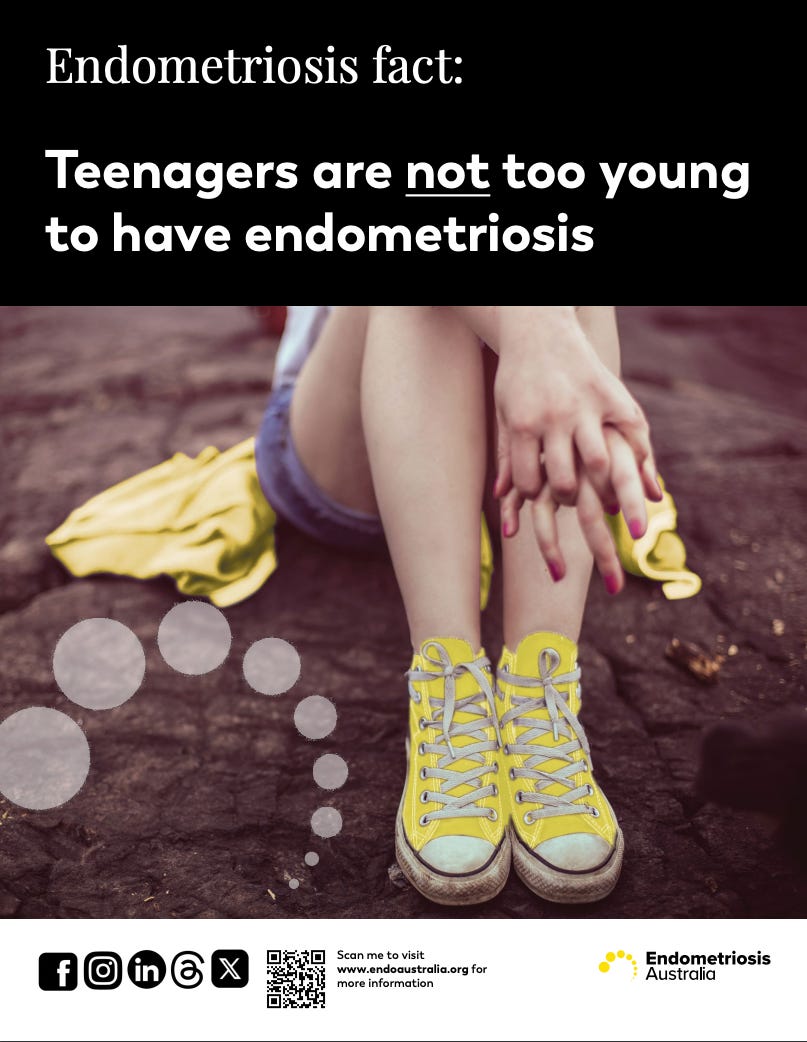March marks Endometriosis Awareness Month, a time to shed light on a condition that affects 1 in 9 women and people assigned female at birth—yet remains poorly understood, under-researched, and often dismissed. Despite its prevalence and the excruciating pain it causes, endometriosis is still routinely misdiagnosed and can take up to 7-10 years for a proper diagnosis.
For many, it’s not just about physical pain. The impact seeps into every aspect of life—education, careers, relationships, mental health, and even fertility. Yet, the lack of awareness and inadequate medical understanding means countless women are left suffering in silence, gaslit by a system that too often minimises their pain.
As the parent of someone who has struggled with endometriosis since the age of 12, I’ve seen first-hand how brutal and life-disrupting this condition can be. Missing school due to unbearable pain, bouncing from doctor to doctor, being told it’s “just bad periods”—it’s exhausting, frustrating, and completely unacceptable. It’s time for real change.
What is Endometriosis?
Endometriosis occurs when tissue similar to the womb's lining grows outside the uterus. This tissue behaves like the uterine lining—thickening, breaking down, and bleeding during the menstrual cycle—but with nowhere to go. This leads to chronic inflammation, internal scarring, adhesions, and intense pain.
Common locations for endometriosis growth include:
🔸 Ovaries and fallopian tubes
🔸 Bladder and bowel
🔸 Pelvic walls
🔸 Diaphragm, and in rare cases, even the lungs
Yet, despite how widespread and severe it is, many women struggle for years to be believed, let alone diagnosed.
Recognising the Symptoms
Endometriosis presents differently for everyone, which is why so many people go undiagnosed for years. Symptoms can include:
✔ Severe pelvic pain (especially during periods but often at other times too)
✔ Heavy or irregular bleeding
✔ Pain during or after sex
✔ Chronic fatigue and brain fog
✔ Digestive and bladder issues (often mistaken for IBS or UTIs)
✔ Fertility struggles
If you or someone you know is experiencing these symptoms, don’t accept dismissal—push for answers.
Why is Diagnosis So Difficult?
One of the biggest issues with endometriosis is how difficult it is to diagnose. Unlike many other conditions, there’s no simple test—the only way to confirm it is through laparoscopic surgery.
Several factors contribute to delayed diagnosis:
❌ Doctors often dismiss symptoms as “just bad periods.”
❌ It mimics other conditions like IBS, interstitial cystitis, or pelvic inflammatory disease.
❌ Hormonal treatments mask symptoms, making it harder to track the disease progression.
❌ Lack of research and education means many healthcare professionals still don’t know enough about it.
Why Does No One Talk About It?
Endometriosis is a major women’s health issue, yet it’s often overlooked. Here’s why:
🚨 Historical medical bias – Women’s pain has long been dismissed or minimised.
🚨 Lack of research – Despite affecting millions, endometriosis gets a fraction of the funding that other chronic illnesses do.
🚨 Misconceptions – Too many people, including some doctors, still believe it’s just “bad period pain.”
🚨 Taboos around menstrual health – Many women feel ashamed or embarrassed to discuss their symptoms.
What Women Need to Know
💡 Severe period pain isn’t normal. Pain that disrupts your daily life needs medical attention.
💡 If you’re dismissed by a doctor, seek a second opinion. Advocate for yourself—specialists often have far more knowledge than GPs.
💡 Diagnosis can take years—but don’t give up. Keep pushing for the care you deserve.
💡 Treatment varies. Some find relief with hormones, others require surgery—there’s no “one-size-fits-all” approach.
Current Treatment Options
While there’s no cure for endometriosis, there are several treatment options to help manage symptoms:
🔸 Pain management – Anti-inflammatory painkillers, physiotherapy, acupuncture, and lifestyle changes.
🔸 Hormonal therapy – Birth control pills, hormonal IUDs, or other hormone-suppressing medications.
🔸 Excision surgery – The gold standard treatment, where endometriosis tissue is carefully removed.
🔸 Fertility support – IVF and reproductive treatments for those struggling to conceive.
What Needs to Change?
Despite growing awareness, women are still fighting to be heard. Here’s what must happen:
✅ More funding for research – We need better treatments and a non-invasive diagnostic tool.
✅ Earlier education – Girls should learn about endometriosis in school so they can recognise symptoms early.
✅ Medical training improvements – Healthcare professionals must be better equipped to diagnose and treat endo.
✅ Workplace and social support – Women with endometriosis need accommodations at work and greater understanding from society.
Enough is Enough
For too long, endometriosis has been dismissed, downplayed, and ignored. It’s time to stop accepting long diagnostic delays, ineffective treatments, and the minimisation of women’s pain as the norm.
If you or someone you love is struggling with endometriosis symptoms, don’t stay silent. Keep pushing for answers, share your story, and demand better care.
This Endometriosis Awareness Month, let’s amplify the voices of those who have suffered in silence for too long. Women shouldn’t have to fight this hard just to be believed. 💛





